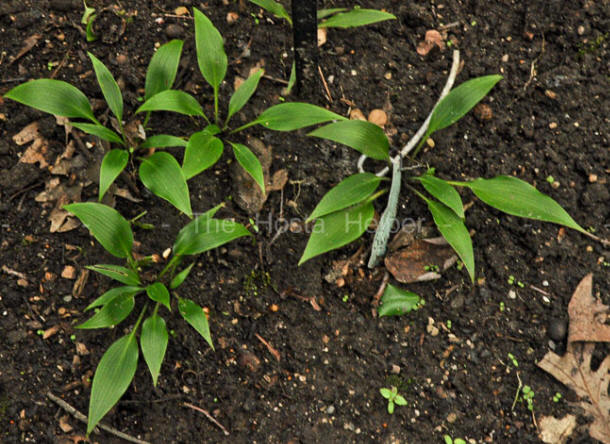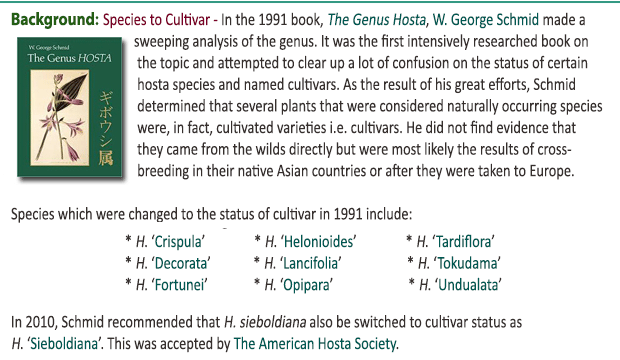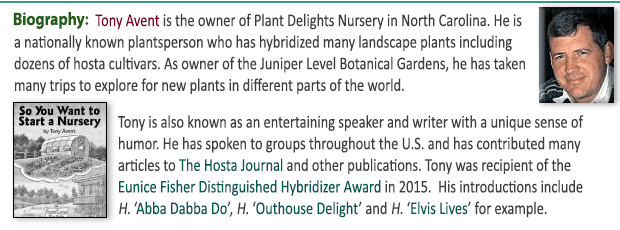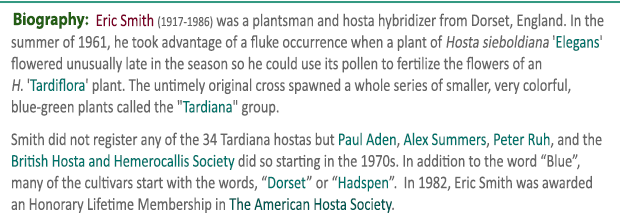|
 The plant label above is incorrectly written as if this hosta were
still considered a species and not a cultivar, which is its current
status. The hosta in the lower image is labeled a little
better...but not quite. The "T" should be capitalized. Nomenclature changes recommended in the
1991 book The
Genus Hosta by
W. George Schmid and accepted by The American Hosta Society would update names as follows:
H. tortifrons is now H. 'Tortifrons'
and H. tardiflora is H. 'Tardiflora'. The plant label above is incorrectly written as if this hosta were
still considered a species and not a cultivar, which is its current
status. The hosta in the lower image is labeled a little
better...but not quite. The "T" should be capitalized. Nomenclature changes recommended in the
1991 book The
Genus Hosta by
W. George Schmid and accepted by The American Hosta Society would update names as follows:
H. tortifrons is now H. 'Tortifrons'
and H. tardiflora is H. 'Tardiflora'.
 The plant is a non-registered seedling of
H. longipes
lancea from
Japan. It was long considered a
species, H. tardiflora, but it was changed to
cultivar status in
The Genus Hosta by W. George Schmid (1991). Today, it is correctly known
as H. 'Tardiflora'. The plant is a non-registered seedling of
H. longipes
lancea from
Japan. It was long considered a
species, H. tardiflora, but it was changed to
cultivar status in
The Genus Hosta by W. George Schmid (1991). Today, it is correctly known
as H. 'Tardiflora'.
 This hosta
has thick, slug resistant green foliage on
a medium size (12 inches high by 36 inches wide) plant. The leaves
are slightly wavy, smooth and very shiny beneath. Its lavender flowers appear
from late September into October and may not have time to mature
to set seed before frost in many northern gardens. This hosta
has thick, slug resistant green foliage on
a medium size (12 inches high by 36 inches wide) plant. The leaves
are slightly wavy, smooth and very shiny beneath. Its lavender flowers appear
from late September into October and may not have time to mature
to set seed before frost in many northern gardens.
This plant has been the mother plant of many sports and
seedlings. The famous blue-green
H." Tardiana" Group which was
developed by English hybridizer
Eric
Smith is a cross between H. 'Tardiflora' × H. 'Elegans'.
The New Encyclopedia of Hostas by
Diana
Grenfell (2009) states: "Autumn flowers make H. 'Tardiflora' a very
valuable hosta...Excellent for warmer climates as it
has a long life cycle."
H. 'Tardiflora' may have been sold
in the past as Mackwoods No. 17.
 
An article about Fall Bloomers by
Herb Benedict and
Jim Wilkins in
The
Hosta Journal (1991 Vol. 22 No. 1) states that, "Here
are some of the fall blooming plants we grow...(listed in the order of bloom
times in Michigan).
| 1) H. kikutii
|
A medium size plant densely flowering
with white blooms. The flowers are equally arranged around the
central axis of the raceme so that the bloom scapes resembles a
bottle brush or pony tail...We are growing two named varieties,
'Hirao-59' and 'Finlandia'. |
| 2) H. 'Fall Bouquet' |
Small, green plant, leaves slightly
undulated, lavender scape and blooms, floriferous. |
| 3) H. longipes |
Small green plant, densely flowering
with a tall stiff bloom scape. The flowers are lavender and the
leaves are green. |
| 4) H. gracillima |
Funnel-shaped, light lavender flowers.
A miniature green plant, with shiny surface. |
| 5) H. 'Iwa
Soules' |
Iwa means rock, and this plant was
imported by Marjorie Soules, from Japan. It is a small green plant
with lavender flowers. |
| 6) H. tortifrons |
In the same section (Picnolepis) as
H. longipes and
H. rupifraga. Distinctive small plant, with twisted
green leaves and lavender flowers. |
| 7) H. 'Fused Veins' |
Small, green leaves often with ¼ inch
margin which is a lighter green. The lance shaped leaves are
undulated and the veins come together regularly. The flowers are
mauve and the scape is sometimes branched. |
| 8) H. rupifraga |
Small, medium green, with thick,
leathery, ovate leaves. Densely flowering with purple flowers. 'Urajiro',
'Grand Slam', 'Maruba Iwa' |
| 9) H. tardiflora |
This small hosta is the last to bloom
for us. Its leaves are shiny, dark green and lance shaped. The
flowers are light lavender and borne in abundance on 12 inch scapes. |
The article includes their
observations about using fall blooming hostas in hybridizing programs:
| 1) H. tardiflora × self |
Tends to flower 2 weeks earlier. 90% of
the progeny have the flowers secund (flowers all on one side of the
bloom stalk) and in 10% they are evenly arranged around the central
axis of the raceme (nonsecund). |
| 2) H. rupifraga × H. tardiflora |
Beautiful very tough plant with a
taller bloom stalk. Blooms 2 weeks earlier. |
| 3) H. 'Maruba Iwa' × H. tardiflora |
Taller bloom stalk. Blooms 2 weeks
earlier. 30% of progeny have nonsecunded flowers. |
| 4) H. gracillima × H. tardiflora |
Very nice small plant, with leaves
intermediate between the two. Beautiful flowers. |
| 5) H. rupifraga ×
H. kikutii |
The best of this cross is called 'Roys
Pink'. It is a perfect intermediate. The leaf is long, heart shaped
and very thick. The flowers are pony tail in type, a light pinkish
color and spent flowers drop off cleanly. |

 In an article about hybridizing by
Tony Avent in
The
Hosta Journal (1996 Vol. 27 No. 1), Tony gives the
following comments on cultivars he has introduced: "H. 'Andy Taylor' -
outstanding dark green matte finish hosta with wonderful pure white flowers...An
'August Moon' x H. 'Tardiflora' cross...will never knock your socks off, but
truly wonderful!" In an article about hybridizing by
Tony Avent in
The
Hosta Journal (1996 Vol. 27 No. 1), Tony gives the
following comments on cultivars he has introduced: "H. 'Andy Taylor' -
outstanding dark green matte finish hosta with wonderful pure white flowers...An
'August Moon' x H. 'Tardiflora' cross...will never knock your socks off, but
truly wonderful!"
An article by Warren I. Pollock in
The
Hosta Journal (2010 Vol. 41 No. 1) states that, "Curiously, the patent for 'El Nino' states it is a "hybrid of 'Halcyon' × a
selection of H. 'Tardiflora'...Hosta authorities agree that most likely 'El Nino'is not a seedling of 'Halcyon', but a sport of 'Halcyon' found in a
tissue-cultured batch in the
Netherlands."








 |



